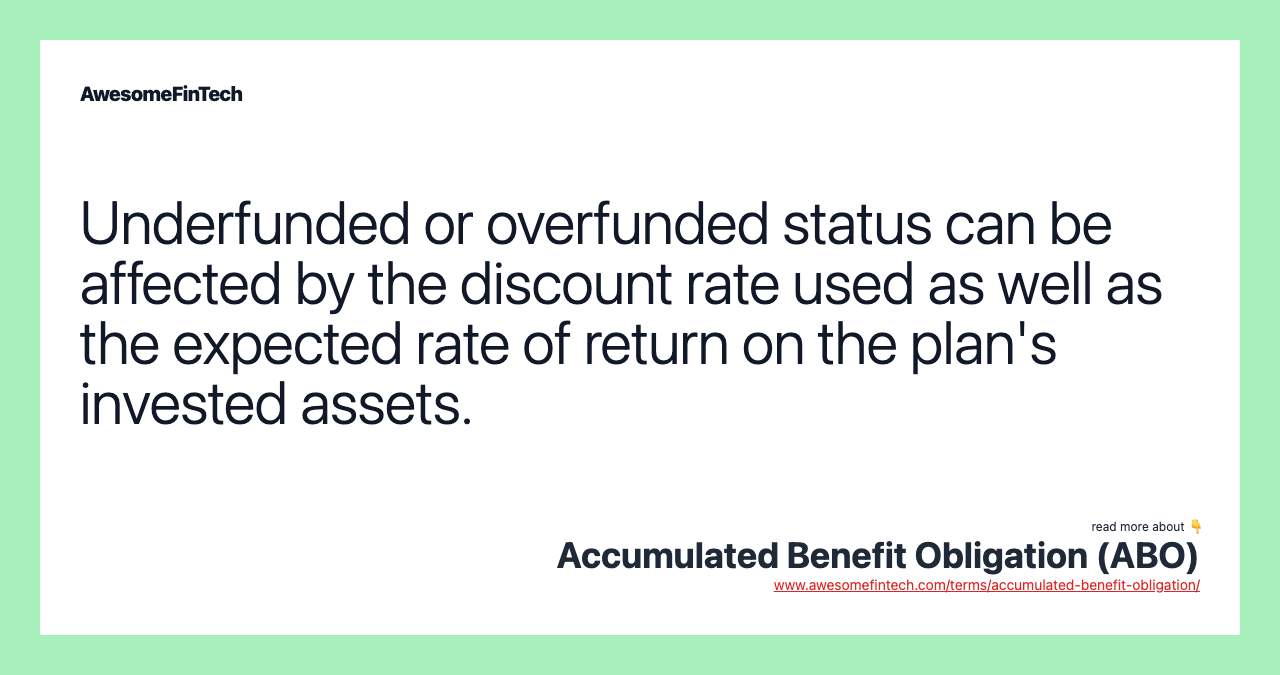Accumulated Benefit Obligation (ABO)
Accumulated benefit obligation (ABO) is the approximate amount of a company's pension plan liability at a single point in time. Accumulated benefit obligation is the present value of the amounts that a pension plan expects to pay employees during retirement based on accumulated work service and current salary levels (i.e., no future salary increases) at the time of the pension liability measurement. If the accumulated benefit obligation (ABO) is above the pension plan's assets, then the plan is underfunded. Accumulated benefit obligation (ABO) is equal to the present value of the future amount that a pension plan expects to pay an individual during their retirement. The assumption for the accumulated benefit obligation (ABO) is that the pension plan will be terminated immediately, meaning that there will be no more future salary increases.

What Is Accumulated Benefit Obligation (ABO)?
Accumulated benefit obligation (ABO) is the approximate amount of a company's pension plan liability at a single point in time. ABO is estimated based on the assumption that the pension plan is to be terminated immediately; it does not consider any future salary increases. This differs from the projected benefit obligation (PBO), which assumes that the pension plan is ongoing, and thus accounts for future salary increases.






Understanding Accumulated Benefit Obligation (ABO)
At the end of each accounting period, the Financial Accounting Standards Board requires companies to file FASB Statement No. 87, which quantifies and discloses pension liabilities in addition to the financial position and performance of their pension plans. There are three ways to measure this: accumulated benefit obligation (ABO), projected benefit obligation (PBO), and vested benefit obligation (VBO).
Accumulated benefit obligation is the present value of the amounts that a pension plan expects to pay employees during retirement based on accumulated work service and current salary levels (i.e., no future salary increases) at the time of the pension liability measurement.
Changes in annual ABO are mainly a result of changes in service costs, interest costs, contributions by plan participants, actuarial gains or losses, benefits paid during the year, and foreign exchange gains or losses, if applicable.
ABO and PBO are similar, but ABO does not provide for future salary increases whereas PBO does. As a result, PBO is a more accurate measure of a company's pension liability to its employees, because it assumes salary increases over time, hence, an increase in liabilities that it must be prepared to payout.
When comparing the ABO to the value of the plan's assets, the plan's assets can either be overfunded or underfunded. If ABO is higher than the plan's assets, then there is a shortfall and the pension plan is underfunded. If the plan's assets exceed ABO, then the pension plan is overfunded.
Accumulated Benefit Obligation (ABO) Calculation Factors
Underfunded plans are booked as a long-term liability on the balance sheet of a company. As ABO is a present value calculation, there are two major drivers that determine if a plan is underfunded or overfunded. The two assumptions are the discount rate used in the present value calculation and the expected long-term rate of return on the plan's assets.
If there is a decline in the assumed discount rate, the estimated underfunded amount will increase (or an overfunded amount will decrease), all else equal. On the other hand, if the assumed rate of return on plan assets is increased, an underfunded amount will fall (or an overfunded amount will rise), holding all other variables constant.
Real World Example
A financial statement note in Raytheon Company's 10-K for the fiscal year of 2016 details ABO, PBO, and plan asset amounts. ABO for domestic pension plans was $22.1 billion, meaning that the company had a liability to pay its employees a pension amount of $22.1 billion. The current value of the pension plan was $17.8 billion.
As the liability amount of $22.1 billion was higher than the plan's assets of $17.8 billion, the plan was underfunded by $4.3 billion. This amount was recorded as part of "Accrued retiree benefits and other long-term liabilities" on the company's balance sheet.
Related terms:
10-K
A 10-K is a comprehensive report filed annually by a publicly traded company about its financial performance and is required by the U.S. Securities and Exchange Commission (SEC). read more
Accounting
Accounting is the process of recording, summarizing, analyzing, and reporting financial transactions of a business to oversight agencies, regulators, and the IRS. read more
Accrued Monthly Benefit
An accrued monthly benefit is the dollar amount of the pension that an employee can expect to receive after retiring. read more
Actuarial Gain Or Loss
Actuarial gain or loss refers to adjustments made to the assumptions used to value a corporation’s defined benefit pension plan obligations. read more
Discount Rate
"Discount rate" has two distinct definitions. I can refer to the interest rate that the Federal Reserve charges banks for short-term loans, but it's also used in future cash flow analysis. read more
Financial Accounting Standards Board (FASB)
The Financial Accounting Standards Board (FASB) is an independent organization that sets accounting standards for companies and nonprofits in the United States. read more
Financial Statements , Types, & Examples
Financial statements are written records that convey the business activities and the financial performance of a company. Financial statements include the balance sheet, income statement, and cash flow statement. read more
Fully Funded
"Fully funded" is a term that describes a pension plan that has sufficient assets to provide for all of its obligations. read more
Projected Benefit Obligation (PBO)
A projected benefit obligation (PBO) is an actuarial measurement of what a company will need at the present time to cover future pension liabilities. read more